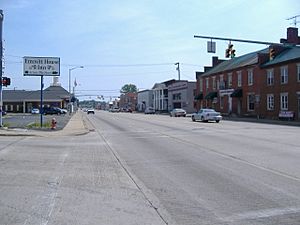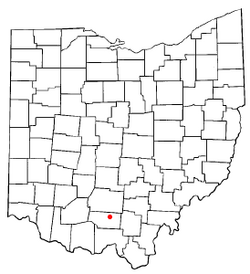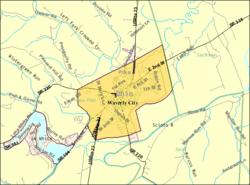Waverly, Ohio facts for kids
Quick facts for kids
Waverly, Ohio
|
|
|---|---|
|
City
|
|

Downtown Waverly
|
|
| Motto(s):
"Working for a Vibrant Future"
|
|

Location of Waverly, Ohio
|
|

Detailed map of Waverly
|
|
| Country | United States |
| State | Ohio |
| County | Pike |
| Area | |
| • Total | 4.22 sq mi (10.93 km2) |
| • Land | 4.16 sq mi (10.78 km2) |
| • Water | 0.06 sq mi (0.15 km2) |
| Elevation | 591 ft (180 m) |
| Population
(2020)
|
|
| • Total | 4,165 |
| • Density | 1,000.24/sq mi (386.23/km2) |
| Time zone | UTC-5 (Eastern (EST)) |
| • Summer (DST) | UTC-4 (EDT) |
| ZIP code |
45690
|
| Area code(s) | 740 |
| FIPS code | 39-81935 |
| GNIS feature ID | 1085666 |
Waverly is a city in Pike County, Ohio, United States. It is also the county seat, which means it's where the main government offices for the county are located. Waverly is about 14 miles (23 km) south of Chillicothe. In 2020, about 4,165 people lived there.
The town started in 1829. This happened when the Ohio and Erie Canal was being built. The canal brought new growth to the area along the Scioto River. Later, in 1861, Waverly became the county seat, taking over from Piketon. The city has its own public library, called the Garnet A. Wilson Public Library.
Contents
Exploring Waverly's Past
Early People and Cultures
Historians think that people lived in the Waverly area as far back as 13,000 BC. The first clear signs of a specific culture are from the Adena people, around 1000 to 800 BC. The area around Waverly has many signs of the Adena, including several ancient mounds. The Adena people were named after a place near Chillicothe where their artifacts were found.
Around 300 BC, the Hopewell culture appeared in the Waverly area. Like the Adena, the Hopewell are famous for their mounds. Many of these mounds can still be seen in southern Ohio, including some in Pike County. There is evidence of the Hopewell until about 600 AD. After them, around 1000 AD, the Fort Ancient people lived in southern Ohio. They disappeared in the 1600s, possibly due to diseases from early European contact.
Later, the Shawnee Native American tribe lived in the area. It's not known if they were related to the Fort Ancient people. As European settlers moved into Ohio, the Shawnee were pushed west. They had many conflicts with settlers, including Tecumseh's War.
One of the most famous Shawnee leaders, Tecumseh, was born near Waverly in 1768. He started fighting to protect his people's land when he was just 15. Tecumseh became a brave leader and is still remembered as an American hero.
European Settlers Arrive
Europeans started settling near Waverly, in what is now Pike County, around 1796. Pike County was named after General Zebulon Pike, a war hero from the War of 1812. He died in 1813 at age 35.
Waverly was officially planned out around 1829 by M. Downing. By 1840, it had 306 residents. It was first called Uniontown. The name was changed to Waverly by Francis Cleveland, who admired the Waverley Novels by Sir Walter Scott.
The Ohio and Erie Canal's Impact
The Ohio and Erie Canal reached Waverly in the early 1830s. This canal greatly changed southern Ohio and helped Waverly grow. The canal's path was likely changed to pass through Waverly. Important people like Robert Lucas and James Emmitt helped make this happen. They owned land and businesses along the new canal route. James Emmitt even owned the first canal boat to travel through the canal, named the Governor Worthington.
Becoming the County Seat
After several years of debate, Waverly became the county seat of Pike County in 1861. It has been the county seat ever since. In 1859, James Emmitt and others wanted to move the county seat from Piketon to Waverly. Piketon had been the county seat for over 45 years, so many people there did not want the change.
To convince people, supporters of Waverly promised to build a new courthouse. This courthouse still stands on Second Street in Waverly today. Also, James Emmitt and others built a bridge across the Scioto River in Waverly. Before this, people had to use a ferry to cross. These efforts helped Waverly win the vote. On November 11, 1861, the county offices officially moved to Waverly.
James Emmitt and the Emmitt House
James Emmitt was a very important person in Waverly in the 1800s. He was one of the richest and most powerful people in southern Ohio. Emmitt had many successful businesses, including distilleries, mills, and canal boat companies.
His most famous project was the Emmitt House, a restaurant and tavern. It was built in 1861 but sadly burned down in January 2014. A carpenter named Madison Hemings helped build the Emmitt House. Some historians believe Madison Hemings was the son of President Thomas Jefferson.
From Civil War to the Atomic Age
Waverly was affected by the American Civil War (1861-1865). More than 100 people from Pike County died during the war. In 1863, a group called Morgan's Raiders passed through Waverly.
Many Pike County residents served in World War I and World War II. During World War II, new jobs in war industries gave people other options besides farming or working in sawmills. After World War II, large farms started buying up smaller family farms. Pike County had 1,700 farms in 1940, but only 450 by 1970.
In 1953, the U.S. government chose Pike County for the Portsmouth Gaseous Diffusion Plant. This plant was built to enrich uranium. The time when the plant was built is called the "Boom." Hundreds of new people came to the county for construction and later to work at the plant. New housing was built, schools improved, and many new businesses started. At its busiest, the plant covered almost 4,000 acres and employed over 2,000 workers.
Geography and Climate
Waverly covers about 4.26 square miles (11.03 km2) of land. Most of this is land, with a small amount of water.
Waverly's Weather
Waverly has a climate with warm summers and cold winters. The hottest month is usually July, and the coldest is January. The area gets a good amount of rain throughout the year. Snowfall is common in winter months like January and February.
Who Lives in Waverly?
| Historical population | |||
|---|---|---|---|
| Census | Pop. | %± | |
| 1840 | 306 | — | |
| 1850 | 678 | 121.6% | |
| 1860 | 1,057 | 55.9% | |
| 1870 | 1,202 | 13.7% | |
| 1880 | 1,539 | 28.0% | |
| 1890 | 1,567 | 1.8% | |
| 1900 | 1,854 | 18.3% | |
| 1910 | 1,803 | −2.8% | |
| 1920 | 1,625 | −9.9% | |
| 1930 | 1,603 | −1.4% | |
| 1940 | 1,757 | 9.6% | |
| 1950 | 1,679 | −4.4% | |
| 1960 | 3,830 | 128.1% | |
| 1970 | 4,858 | 26.8% | |
| 1980 | 4,603 | −5.2% | |
| 1990 | 4,477 | −2.7% | |
| 2000 | 4,433 | −1.0% | |
| 2010 | 4,408 | −0.6% | |
| 2020 | 4,165 | −5.5% | |
| U.S. Decennial Census | |||
Population Details (2010)
In 2010, there were 4,408 people living in Waverly. These people lived in 2,035 households. Most residents (96.2%) were White. About 1% were African American, and smaller percentages were Native American or Asian.
About 24.4% of households had children under 18. The average age in Waverly was 48 years old. About 19.5% of residents were under 18, and 27.8% were 65 or older. There were slightly more females (53.4%) than males (46.6%).
Learning in Waverly
The Waverly City School District runs several schools:
- Waverly Primary School
- Waverly Intermediate School
- Waverly Junior High School
- Waverly High School
Waverly also has a public library, which is part of the Garnet A. Wilson Public Library system.
Famous People from Waverly
Waverly is the hometown of the band Pure Prairie League. This band was a pioneer in the country rock music style.
Images for kids
See also
 In Spanish: Waverly (Ohio) para niños
In Spanish: Waverly (Ohio) para niños



